The people of Ypsilanti are currently going through the process of rewriting the City’s Master Plan. The exhaustive undertaking, which has been constructed in such a way as to incorporate the input from as many community members as possible, is already well under way, but, over the coming months, there will still be ample opportunities for folks to engage and contribute their ideas. In hopes of finding out more about the process, I reached out to Ypsilanti City Planner Teresa Gillotti, and Ypsilanti City Planner Emeritus Richard Murphy, who currently serves on the Steering Committee which has been charged with seeing the undertaking, which has been dubbed “Shape Ypsi,” through to completion. Here’s our exchange.

MARK: First, let’s start with what a Master Plan is, and why the city needs one. I think I know the answer, but I’m curious as to what you’ll say.
TERESA: The Master Plan is the guiding document for the city’s next 10-20 years. Practically, it’s something that I use frequently, as do others, to make sure that the projects we take on are in-line with the community’s vision as to where the City should be heading. The implementation tool of the Master Plan is the zoning ordinance, and that revision will follow the drafting of a new Master Plan… I think it’s important for Ypsilanti, especially now that we’ve gone through de-industrialization, and both a housing boom and bust. There are questions as to where we want go, in terms of our economy, our neighborhoods, and the transportation options available to us. In a time of diminishing resources, it’s still important to make deliberate choices, and to build on the existing physical infrastructure and our community character, which is Ypsilanti’s greatest strength. Ypsi is growing and changing, and sticking with the current plan, and the zoning requirements which were drafted to support it, limits where we can go. It’s time to rethink and redefine the City’s direction together as a community.
MARK: Are Master Plans required by law? Are there communities without them?
TERESA: The State of Michigan Planning Enabling Act requires the State’s Planning Commissions to develop and adopt a Master Plan, as well as update it every 5 years.
MARK: When did we last go through this process? Was it at all contentious? If so, why?
TERESA: The last time the process happened was in the late 1990s. (Our current plan, which was largely written in 1998, can be found here.) I don’t know the details of the process… maybe folks can discuss it in the comments section. I do know that, with most large-scale zoning changes, there is often concern as folks try to stay abreast of changes that might impact their neighborhoods, properties and commercial districts. After the Master Plan is adopted, the next stage is to move toward a major zoning ordinance revision, and a “form based code.” I expect that will also draw attention and opinions. I’m hoping for creativity and exploration, although I know sometimes it’s easy to take on a defensive posture when it comes to potential changes to one’s own property.
 MARK: I’m not familiar with the phrase, “form based code.” What’s that?
MARK: I’m not familiar with the phrase, “form based code.” What’s that?
MURPH: A “form based code” is a zoning ordinance that focuses most of its attention on the physical aspects of a building and site — how big is it, where is it relative to the street and sidewalk and neighboring properties, how much parking does it have — and spends less time listing the uses that are permitted or prohibited on the site. The form-based approach has gained in popularity in recent years as a way to focus regulations on the aspects of development that have the greatest impact on community character, and reducing the amount of micromanaging of what types of businesses can exist in a particular building.
MARK: Thanks, Murph. That makes more sense…. Earlier, Teresa, you mentioned that Michigan law requires that we update the Master Plan every five years. Is it safe to assume that, while we haven’t rewritten ours from scratch in some time, we have made edits to reflect changing circumstances? Assuming that’s the case, I’m curious to know what the most recent changes have been.
TERESA: In 2008, the City amended the Water Street area plan, and, in 2010, the City amended the Master Plan to include the Non-Motorized Transportation Plan. No overall update has been completed since 1998, though.
MURPH: We’ve done small amendments as individual developments came up, too — when Ave Maria closed their campus on Forest Avenue, for example, we had to amend the plan’s “future land use map” to allow anything other than an institutional use there.
MARK: How do people, if they want to engage in the process, go about doing so?
TERESA: This week, we’re in the Discover Charette phase of the process, and there are a number of events taking place. It’s essentially a week-long workshop that started with a Community Conversation on Tuesday night. (Thanks to the 50-some folks who attended!) Then, on Wednesday, and again today, we had the studio open at 206 West Michigan Avenue for people to drop in and give us their ideas and opinions as to what to preserve, change or create in the City. There were posters with questions related to our various housing and commercial areas, with the intention of getting the community to weigh in on what’s working and what’s not. And, on Friday, we’ll be reporting back what we’ve learned – showing images of what things currently look like, and sharing ideas as to where we’ll go from here. That will be at 5:00 PM, at SPARK East… Then, we do it again in April at the Design Charette. There, the planning team will have examples and sketched-out scenarios for people to respond to. We’ll have a public meeting to start it, another studio event, and other neighborhood meetings similar to what’s happening this week, wrapping up with another Friday presentation. We’ll keep the website up-to-date on the details.
MARK: Have we done what you would consider a good job of benchmarking other cities? I’m curious to know if, in the process of doing so, we’ve come up with any ideas that might be worth considering here? For instance, I didn’t read it yet, but a friend sent me an article awhile ago about an ordinance that was passed somewhere on the west coast that made it easier to construct secondary housing units on one’s property, as a way of increasing density, etc. If I’m not mistaken, the article made the case that doing so proved to be incredibly beneficial for the community in question. I’m not suggesting that we do that specifically, but I’m curious as to how broadly we’re casting our net. Is everything on the table?
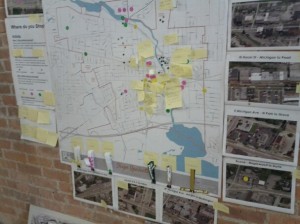 TERESA: This is where our planning team comes in. They’ve done work in Michigan and the Midwest, as well as Florida, Vancouver (where everything is lovely), and tons of other places. We get to rely on their experience, and, yes, everything is on the table. In focus groups, and already this week, we’ve talked about travel lane conversions, roundabouts (what?), development in and around Depot Town, dinosaurs on the Water Street Trail, relocating the Ypsi bus terminal, the reuse and new development on the old Boys and Girls Club site on Park Street, and and that’s just what’s at the top of my mind after a long day of talking with folks. Planning out 10-20 years gives us more room to shape the city in ways as simple as making available more uses in downtown districts to encourage more business, to rethinking our street network, and imagining reuse scenarios for underutilized sites. Someone suggested a rollercoaster today – not sure where that will go – but yes, bring the ideas.
TERESA: This is where our planning team comes in. They’ve done work in Michigan and the Midwest, as well as Florida, Vancouver (where everything is lovely), and tons of other places. We get to rely on their experience, and, yes, everything is on the table. In focus groups, and already this week, we’ve talked about travel lane conversions, roundabouts (what?), development in and around Depot Town, dinosaurs on the Water Street Trail, relocating the Ypsi bus terminal, the reuse and new development on the old Boys and Girls Club site on Park Street, and and that’s just what’s at the top of my mind after a long day of talking with folks. Planning out 10-20 years gives us more room to shape the city in ways as simple as making available more uses in downtown districts to encourage more business, to rethinking our street network, and imagining reuse scenarios for underutilized sites. Someone suggested a rollercoaster today – not sure where that will go – but yes, bring the ideas.
MARK: I’m reminded of the situation a few years ago when EMU made a move to close College Place, one of the main thoroughfares which connects the University with the City. I don’t recall if, in the ensuing debate, the Master Plan was ever invoked, and that makes me wonder if it has teeth. I guess what I’m asking is, how enforceable is the Master Plan?
TERESA: That was part of a neighborhood plan that I don’t believe was ever formally adopted. The teeth of any Master Plan is the subsequent zoning ordinance, and community by-in. If people are included in the plan, and invested in the process, then, in addition to the ordinance, their support and encouragement to move forward will keep it active and relevant.
MARK: What are some of the more ambitious ideas that have come to the surface so far? Is anyone pushing for a downtown garbage incinerator, or zoning changes that would allow for a Water Street hog processing plant? Is anyone advocating for the selling of public park space? Has anyone argued for the lessening of historic district standards?
MURPH: I haven’t heard anything shocking — apparently I missed the dinosaur rollercoasters. There was some talk about reconfiguring the Cross & Washtenaw intersection, to put the water tower at the center of a roundabout; a lot of talk about turning the one-way streets into two-ways (the traffic engineers seem to think this is realistic); consolidating all the tobacco and medical marijuana businesses and the Vu into a vice district; generating all of our own energy in town. Strong support for getting a burrito place in town.
MARK: I imagine one of the major drivers behind the drafting of this new Master Plan is our desire to make something happen on Water Street. What, specifically, are the major issues, as you see them, which need to be addressed relative to that particular 38-acre downtown parcel?
TERESA: It has less to do with Water Street than it does making relevant an out-of date plan that had no direction for redeveloping a former industrial properties (the former Ford plant), no concept of our housing needs post housing crisis and with higher unemployment impacting our neighbors’ abilities to keep their homes. It doesn’t talk about addressing inequities that exist within the community, and it doesn’t speak well of managing and building off our natural resources or any of the legs of the sustainability table. The current plan was revised to address redevelopment of Water Street a few years ago, and Water Street is important, but so is addressing difficulty of pedestrians to get from EMU to downtown due to traffic flying through town. The Master Plan is bigger than any one piece.
But you didn’t quite ask me that. The community worked together on a full plan for Water Street in 1999. That resulted in Biltmore’s proposal for the site, and later Freed’s in 2006. It’s fine that today we’re willing to sell off portions of the site, as a developer would, to construct in phases. What’s tricky is that we don’t have a clear picture as to how we should guide that development. The City needs to set the stage with an idea of the form we’re looking for on the site, how to provide the infrastructure, and a clear process for seeking and guiding developers through construction. Currently staff can’t say to a developer – “Yes, we want that type of development in that location.” Every aspect is up for negotiation, almost to the point where the community has to convince itself each time that this is a good idea. (And you can interpret that to be a single project or the whole Water Street idea.) We know Water Street has baggage, and it will never be perfect. Nonetheless, we have to have a direction. It can’t be, “I’ll know it when I see it.” We have to find a direction and then we all have to get out of the way and make it happen.
MARK: What are the most common complaints you hear about the current Master Plan?
TERESA: Mainly that it doesn’t seem to reflect the creative, active community we have now… Which doesn’t mean that it failed. It just means it’s time for us to take the next step.
MURPH: The Master Plan is supposed to provide policy guidance to the Planning Commission especially as we consider zoning amendments or applications that we have some discretionary role in. Looking at it from 15 years later, I see the 1998 Master Plan as focused on “clean up”, on dealing with the sore thumbs and nuisance issues in various neighborhoods. For one thing, I think the city has achieved a lot of those goals–closing nuisance businesses that were operating illegally; getting dangerous buildings torn down or fixed up; etc.–and can focus less on those issues. The other side of this is that, since the plan focused on the details of what we had at the time, it didn’t provide much guidance for other developments: there’s no indication in the 1998 plan of what should be done with the old Ford/Visteon/ACH property, for example, because the plant was operating at the time and didn’t seem to be a concern. Similarly, when we undertook zoning ordinance amendments to more clearly permit arts-based businesses in town, there was nothing in the Master Plan that gave useful guidance on this.
I’d like to see our new master plan provide a better policy framework for things that aren’t anticipated at the time of the plan: rather than a checklist of “do this, then do this, then do this”–the old plan has several hundred very detailed recommendations about individual properties or specific programs–we need guidelines for how to approach various situations that we can’t anticipate. We’ll still have specific action steps in the new plan, but I like the starting point of talking about our values as a community, because these are higher-level things that can be applied when considering unforeseen things that come in front of us.
MARK: And this whole process is being called “Shape Ypsi,” which, to me, sounds like a local women’s gym franchise… but I suspect you’ve been hearing that a lot.
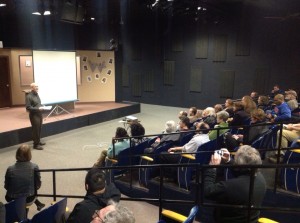 TERESA: I thought that myself, but most people have been kind enough not to say it. In our focus groups, we’ve been literal, giving folks playdough with which to reimagine the “shape” of Ypsilanti. I have been impressed by clock towers and tridges. There was also a castle (they were trying to convey that there were too many moats), an “elephant in the room,” and a Water Tower. I was surprised that we only had one of those.
TERESA: I thought that myself, but most people have been kind enough not to say it. In our focus groups, we’ve been literal, giving folks playdough with which to reimagine the “shape” of Ypsilanti. I have been impressed by clock towers and tridges. There was also a castle (they were trying to convey that there were too many moats), an “elephant in the room,” and a Water Tower. I was surprised that we only had one of those.
MARK: I like that the website which has been launched to accompany the process allows for people to post questions. So far, though, there aren’t that many. I liked the comment from the person who wanted to suggest that we not pursue a local rail stop, as it would act as a portal, allowing nefarious Detroiters a way to enter Ypsilanti, as though they couldn’t find their way here by car, or some other form of conveyance.
TERESA: That was our first comment on the website! The second comment at Tuesday’s meeting, was about the problem of public urination, something I clearly haven’t thought about enough… We slowed down on the online questions once we started the focus groups, but I have a feeling that, after this week, we’ll put up a few more. Or, maybe you could give us suggestions on what we’ve yet to ask that needs to be asked.
MARK: How are things ultimately decided on? Does the Steering Committee vote on what’s included? And, once they’re done with the document, does it get voted on by City Council? Is there a process by which members of City Council members can then advocate for changes? Also, as I mentioned the Steering Committee, who’s been appointed to serve on it?
TERESA: The Steering Committee was formed by the Planning Commission. They ultimately will adopt the plan, but only after City Council approves release of the Master Plan to other communities for review (per state ordinance). The Steering Committee is guiding the process overall and will continue to work on outreach and championing the process and ultimate plan, as we hope other people in town will including City Council as well.
 Here’s the Steering Committee:
Here’s the Steering Committee:
Ricky Jefferson (City Council, Ward 1)
Pete Murdoch (City Council, Ward 3)
Rod Johnson (Chair, Planning Commission)
Richard Murphy (Vice Chair, Planning Commission)
Phil Hollifield (Planning Commission)
D’Real Graham (Recreation Commission)
Anne Stevenson (Historic District Commission)
Leigh Greden (EMU administration)
Desmond Miller (EMU student government)
Bee Roll (Business owner)
Teresa Gillotti (Planning staff)
MARK: What are some of the issues being raised in the focus group process that you hadn’t anticipated?
TERESA: A few times people suggested that a guiding value should be fun. I really like that notion.
MARK: Can you give me an example of a guiding value that you think might be appropriate? Do you, for instance, have something in mind like Google’s “Don’t be evil”? Or are you thinking of something a little less broad?
TERESA: We have a draft list of 10 values. None are as catchy as Google’s. The first three are: Safety comes first. Diversity is our strength. Ypsilanti is sustainable. The rest build off of those.
MARK: How would you suggest that people get involved, assuming they can’t make it out to any of the upcoming meetings that you’ve mentioned.
TERESA: If folks can get out tomorrow or Friday that would be great. Otherwise join the listserve on the website or the Facebook group. The team will be back the 3rd week in April for another intensive week. After that, we’ll be putting together a draft plan. So now is the time.



 MARK: I’m not familiar with the phrase, “form based code.” What’s that?
MARK: I’m not familiar with the phrase, “form based code.” What’s that? TERESA: This is where our planning team comes in. They’ve done work in Michigan and the Midwest, as well as Florida, Vancouver (where everything is lovely), and tons of other places. We get to rely on their experience, and, yes, everything is on the table. In focus groups, and already this week, we’ve talked about travel lane conversions, roundabouts (what?), development in and around Depot Town, dinosaurs on the Water Street Trail, relocating the Ypsi bus terminal, the reuse and new development on the old Boys and Girls Club site on Park Street, and and that’s just what’s at the top of my mind after a long day of talking with folks. Planning out 10-20 years gives us more room to shape the city in ways as simple as making available more uses in downtown districts to encourage more business, to rethinking our street network, and imagining reuse scenarios for underutilized sites. Someone suggested a rollercoaster today – not sure where that will go – but yes, bring the ideas.
TERESA: This is where our planning team comes in. They’ve done work in Michigan and the Midwest, as well as Florida, Vancouver (where everything is lovely), and tons of other places. We get to rely on their experience, and, yes, everything is on the table. In focus groups, and already this week, we’ve talked about travel lane conversions, roundabouts (what?), development in and around Depot Town, dinosaurs on the Water Street Trail, relocating the Ypsi bus terminal, the reuse and new development on the old Boys and Girls Club site on Park Street, and and that’s just what’s at the top of my mind after a long day of talking with folks. Planning out 10-20 years gives us more room to shape the city in ways as simple as making available more uses in downtown districts to encourage more business, to rethinking our street network, and imagining reuse scenarios for underutilized sites. Someone suggested a rollercoaster today – not sure where that will go – but yes, bring the ideas.  TERESA: I thought that myself, but most people have been kind enough not to say it. In our focus groups, we’ve been literal, giving folks playdough with which to reimagine the “shape” of Ypsilanti. I have been impressed by clock towers and tridges. There was also a castle (they were trying to convey that there were too many moats), an “elephant in the room,” and a Water Tower. I was surprised that we only had one of those.
TERESA: I thought that myself, but most people have been kind enough not to say it. In our focus groups, we’ve been literal, giving folks playdough with which to reimagine the “shape” of Ypsilanti. I have been impressed by clock towers and tridges. There was also a castle (they were trying to convey that there were too many moats), an “elephant in the room,” and a Water Tower. I was surprised that we only had one of those.  Here’s the Steering Committee:
Here’s the Steering Committee: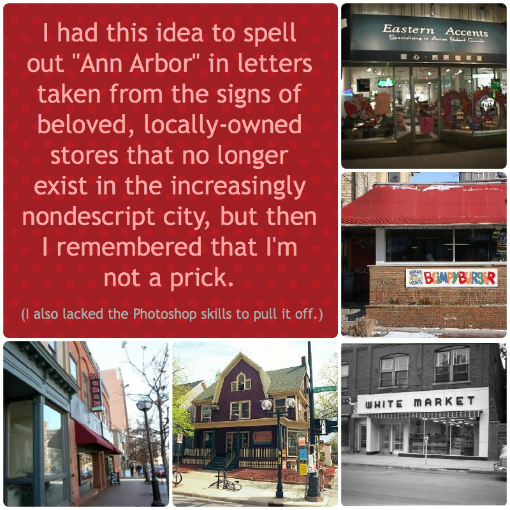
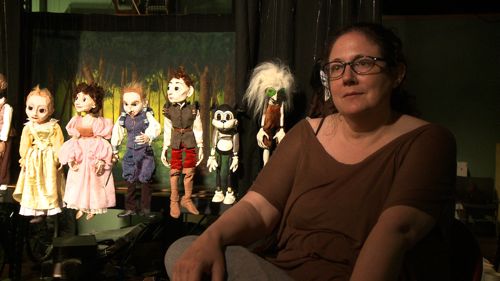
 NAIA: Jamie Klenk, a friend of mine and an excellent photographer (she had an exhibition at Dreamland last year), worked on the movie as the art production assistant. She and the art director, Dina Goldman, were trying to find puppets and puppeteers for the project. They were originally looking in New York (which has a thriving puppet scene), when Jamie suddenly thought of me. She showed Arnaud some photographs that she had taken of my puppets and he loved them and asked to meet with me… I made three new puppets for A Midsummer’s Night Dream including Puck and Bottom, with a swappable head – man and ass. I had to rework the ass head several times to making it menacing enough for Arnuad.
NAIA: Jamie Klenk, a friend of mine and an excellent photographer (she had an exhibition at Dreamland last year), worked on the movie as the art production assistant. She and the art director, Dina Goldman, were trying to find puppets and puppeteers for the project. They were originally looking in New York (which has a thriving puppet scene), when Jamie suddenly thought of me. She showed Arnaud some photographs that she had taken of my puppets and he loved them and asked to meet with me… I made three new puppets for A Midsummer’s Night Dream including Puck and Bottom, with a swappable head – man and ass. I had to rework the ass head several times to making it menacing enough for Arnuad. 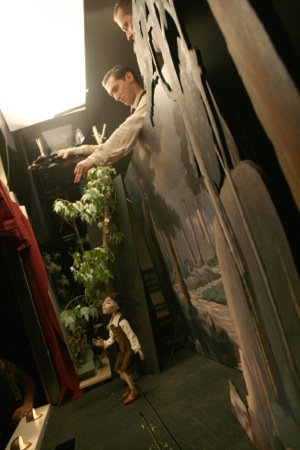 MARK: Were you able to improvise at all, or were they really clear as to what they wanted?
MARK: Were you able to improvise at all, or were they really clear as to what they wanted? NAIA: I did! Justin Lang, another awesome person that did the set design, designed and built the puppet stage using specifications that I gave him. As we approached the day of the shoot, I asked what they were going to do with the stage afterward, and could I have it, and they said, “Yes”! Here’s a photo of the stage on the set (a room in
NAIA: I did! Justin Lang, another awesome person that did the set design, designed and built the puppet stage using specifications that I gave him. As we approached the day of the shoot, I asked what they were going to do with the stage afterward, and could I have it, and they said, “Yes”! Here’s a photo of the stage on the set (a room in  It would seem that Ralph Lange, our new city manager, has made up his mind that we should merge Ypsilanti’s Police and Fire departments in hopes of further delaying landfall of the category-five fiscal storm gathering on the horizon. He’s admittedly in a tough spot, and I’m sympathetic. He’s trying to radically cut spending, in order to stave off bankruptcy and state takeover, without damaging the fabric of our community to such an extent that we’d begin losing the tax-payig families that we currently have, and scare off businesses and individuals who might otherwise be considering investment here. It’s not an enviable task, and I’m not inclined to attack Lange for weighing the options available to us. I am, however, curious as to whether we’ve sufficiently thought through the ramifications of such a drastic course of action.
It would seem that Ralph Lange, our new city manager, has made up his mind that we should merge Ypsilanti’s Police and Fire departments in hopes of further delaying landfall of the category-five fiscal storm gathering on the horizon. He’s admittedly in a tough spot, and I’m sympathetic. He’s trying to radically cut spending, in order to stave off bankruptcy and state takeover, without damaging the fabric of our community to such an extent that we’d begin losing the tax-payig families that we currently have, and scare off businesses and individuals who might otherwise be considering investment here. It’s not an enviable task, and I’m not inclined to attack Lange for weighing the options available to us. I am, however, curious as to whether we’ve sufficiently thought through the ramifications of such a drastic course of action.









